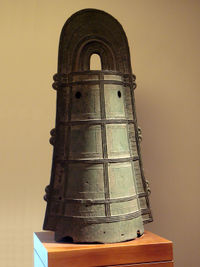On the Origin of Species: Bronzor and Bronzong
|
Bronzor and Bronzong are a pair of Pokémon whose origins eluded me for some time. At first glance, their designs don't seem to make a lot of sense, and it's hard to see how they're even related to each other. Bronzong is clearly a large bell, and I originally presumed Bronzor to be a gong, before learning from its Pokédex entry that it's a mirror. A bronze mirror, specifically – these were manufactured in China from 2000 BC, and made their way to Japan in around 300 AD. It's only in the last few hundred years that glass mirrors have become commonplace.
So, we have a bronze mirror and a bronze bell. Apart from being made of the same metal, what do they have in common? Not much, really, unless you happen to be familiar with a Japanese legend that is best known by the title Of a Mirror and a Bell. It appears in a famous collection of stories entitled Kwaidan: Stories and Studies of Strange Things. The book was published in 1904 and was compiled by Lafcadio Hearn, an Irish-Greek journalist who became a Japanese citizen. Hearn produced numerous accounts of Japanese culture and mythology that served to introduce the West to a people who, at the time, still must have seemed very exotic and unfamiliar.
The story that concerns us begins hundreds of years prior, in Mugenyama in Tōtōmi province. There, the priests wanted a new bell for their temple, and asked for the local women to donate old bronze mirrors, which could be melted down and cast into a bell. One of the mirrors to be donated came from a farmer's wife.
After a while, though, the woman started to regret giving away her mirror, which had been in her family for many years. An old proverb said that a mirror was the soul of a woman, and she started to worry that in giving away her precious mirror, she had also given away her soul. She didn't have the money to buy the mirror back, and whenever she went to the temple, she could see it in amongst the pile of others. She longed to steal it back, but the opportunity never came.
Eventually, all of the mirrors were sent to the foundry to be melted down. Mysteriously, one of the mirrors would not melt: a sign that whoever donated it must not have wanted to give it up. Since the offering wasn't presented with all her heart, her mirror remained attached to her, kept cold in the furnace by her selfish desire. When it was discovered to whom the mirror belonged, the woman couldn't bear the shame, and drowned herself. But before she died, she left a letter stating that, once she was gone, the mirror could be melted and used to cast the bell. However, anybody who struck the bell hard enough to break it would be rewarded with riches by her ghost.
The locals took this dying promise quite seriously, as the last wishes of anyone dying in anger were thought to possess a mystical power. Thus, the possibility of breaking the bell and becoming rich seemed very real. Once the newly-made bell was hung in the temple, people flocked to ring it, striking it as hard as they possibly could. The bell held firm, but still people tried to break it, day after day. This proved hugely annoying for the priests, who had to endure the near-constant ringing of their bell. Soon tiring of the constant noise, the priests took the bell and rolled it down a hill, into a deep swamp. The bell sank in, never to be seen again... and the woman, from beyond the grave, had succeeded in destroying the bell that had caused her so much misery.
Though the story ends here, and we can clearly see the relationship between the mirror and the bell that gave rise to Bronzor and Bronzong, there is still more to be said about this legend... as, curiously enough, it spawned legends of its own. A powerful concept in Japanese folklore is that of nazoraeru (準える), or substitution. An example that Hearn himself gives is that of making a temple to Buddha. The average person could never afford to do this, but by simply laying a pebble before an image of Buddha, with the same degree of dedication that would prompt you to build a temple if you had the means, you would acquire the same merit as if you had actually built one. Essentially, if you don't have the means to do something, you can do something else with the same feelings, and reap the same rewards.
The story of the bell of Mugen, or Mugen-kane (無間鐘), supposedly captured the public's imagination. Though the bell was lost, and with it any chance of reaping the reward for breaking it, that didn't stop imaginative individuals from substituting other items for the lost bell, and breaking them in the hopes of being rewarded. While this might sound like an absurdly desperate act of greed, it's worth pointing out that, in many versions of the legend, the financial reward came at the cost of the person's soul: they would gain riches in life, but be cast in to a particularly nasty corner of Hell upon dying. So the act of re-creating and then breaking the bell of Mugen took on a sacrificial quality, and there were many plays about parents or spouses doing such a thing to provide money for their loved ones, sacrificing their future happiness in order to help those that they loved.
A famous story concerned Umegae, lover of the Heian period samurai Kajiwara Kagesue. Kajiwara had apparently spent all of his money on Umegae, and had to pawn his armor, which became problematic when he was subsequently called to arms. In order to get the armor back, Umegae took a bronze basin and beat it until it broke, while crying out for three hundred pieces of gold. A guest of the inn where they were staying heard the commotion and, upon learning of her plight, actually gave her the money she had cried out for. Thus, the washbasin of Umegae became as much of a legend as the bell of Mugen that had inspired it. Hearn tells us of a song about Umegae's basin that was still being sung by dancing girls at the start of the twentieth century: "If, by striking upon the wash-basin of Umegae, I could make honorable money come to me, then would I negotiate for the freedom of all my girl-comrades."
I've mentioned in previous columns how many Japanese legends seem to mix the tragic and the bizarre, and here we have a tale of suicide, poverty and eternal damnation that nonetheless involves the comical image of people smashing up objects in the hope that they'll be rewarded by a ghost. Hearn wasn't exaggerating when he subtitled his collection Stories and Studies of Strange Things. The motivations of the woman in the origin myth seem especially difficult to comprehend from a modern perspective: giving something away and then regretting it is certainly a very mild form of selfishness, and probably not shameful enough to merit suicide. And perhaps I'm just not romantic, but I have to wonder what sort of samurai pawns his armor to impress his girlfriend.
One reference to the legends in the design of Bronzor and Bronzong that might not be immediately obvious is in their abilities. Both can have the Heatproof ability, rendering them resistant to fire, just like the mirror that refused to be melted down. There are also a few oblique references to the myths in their Pokédex entries. Bronzong, incidentally, is mentioned to be a bringer of good harvests, and the dōtaku (銅鐸), the type of bell on which it is based, was used to pray for good harvests in ancient times. But my favourite Pokédex entry for Bronzong has to be the one from Diamond: "One caused a news sensation when it was dug up at a construction site after a 2000-year sleep." Might this Bronzong, then, be the actual bell of Mugen, finally recovered from the swamp? If so, one should exercise caution while battling it. The payout upon defeating it may be unexpectedly high, but once it's Game Over, there'll be hell to pay...

